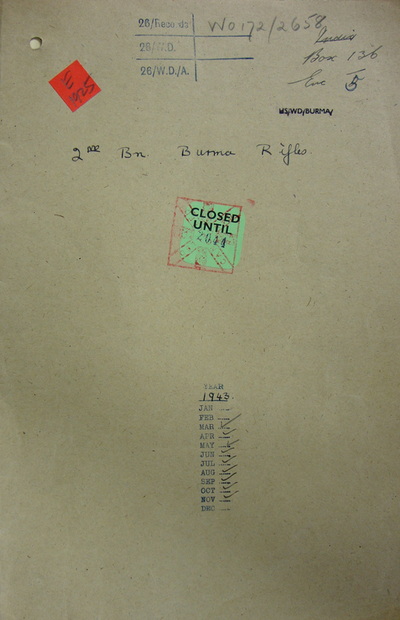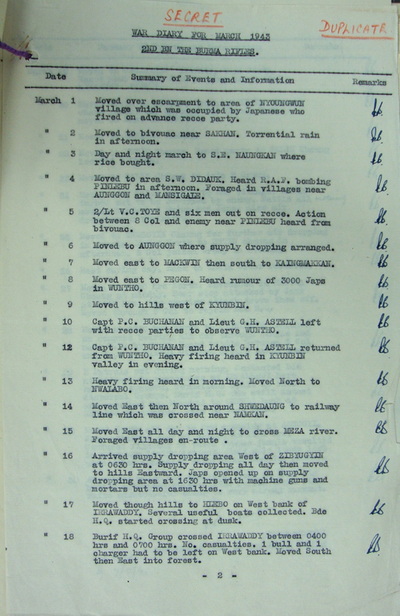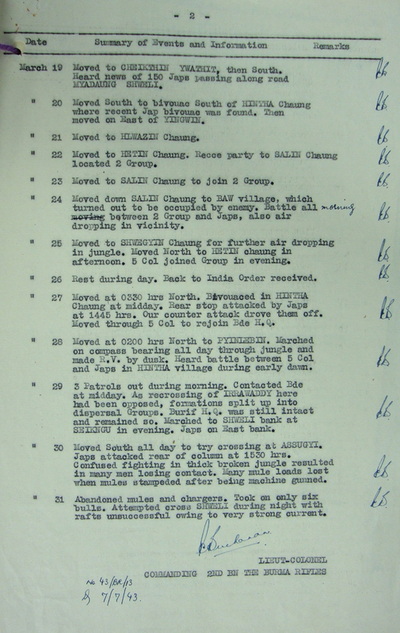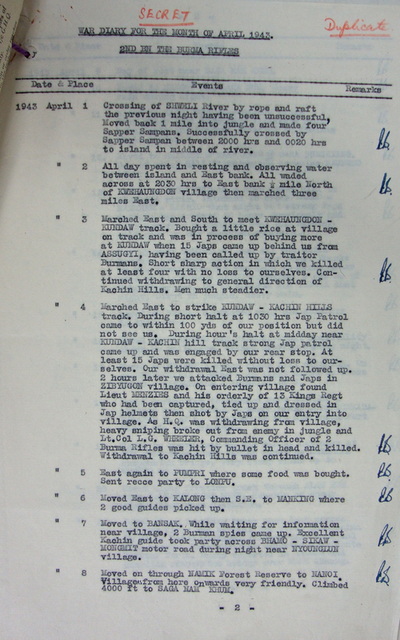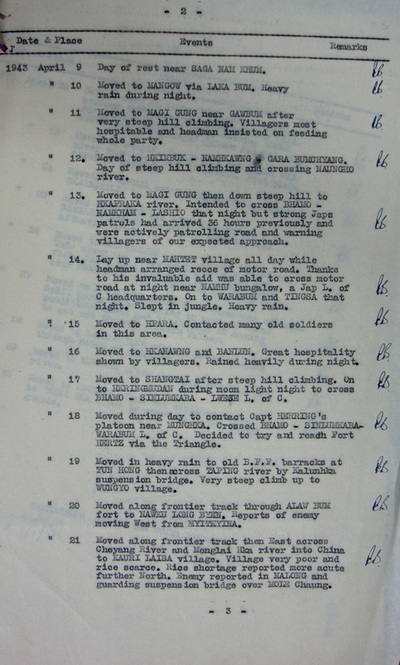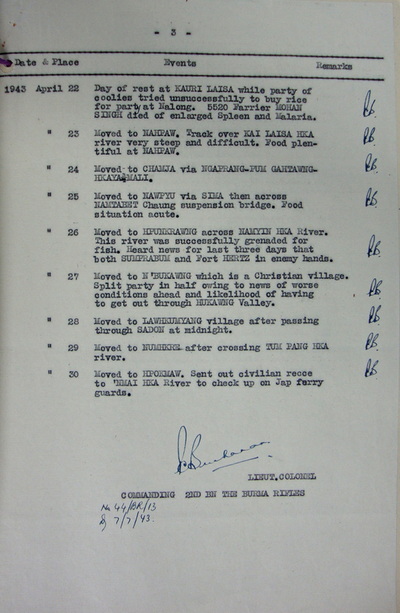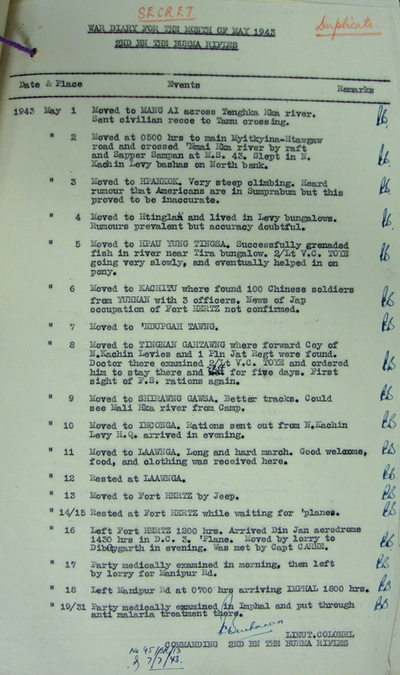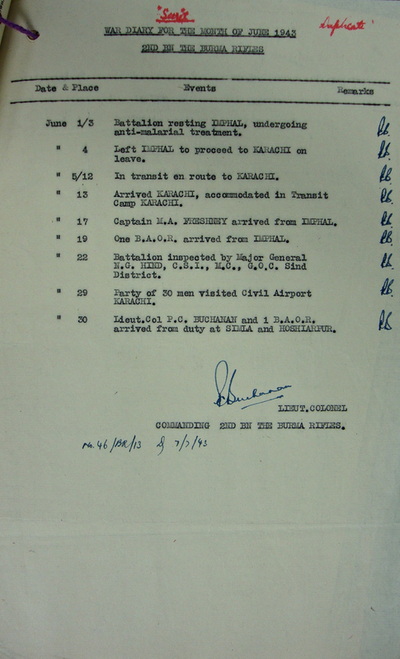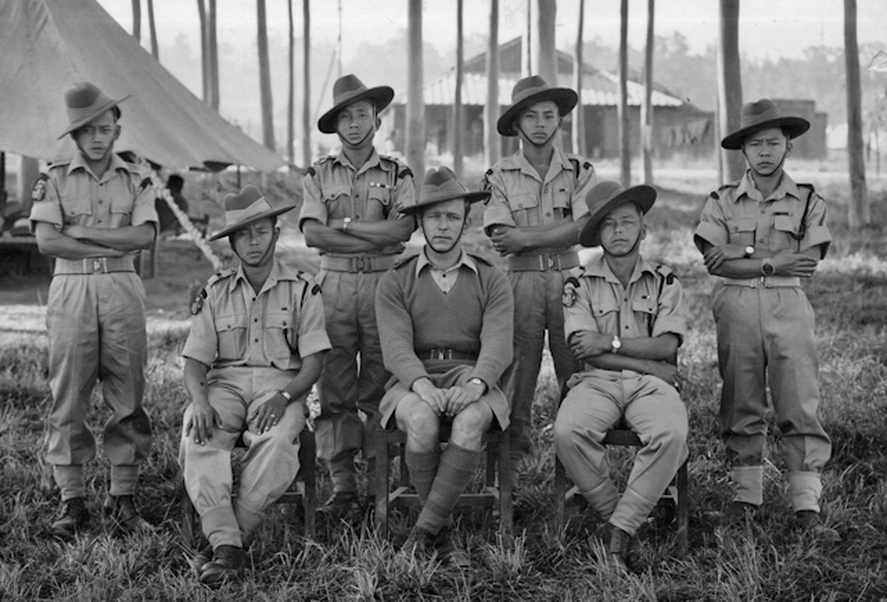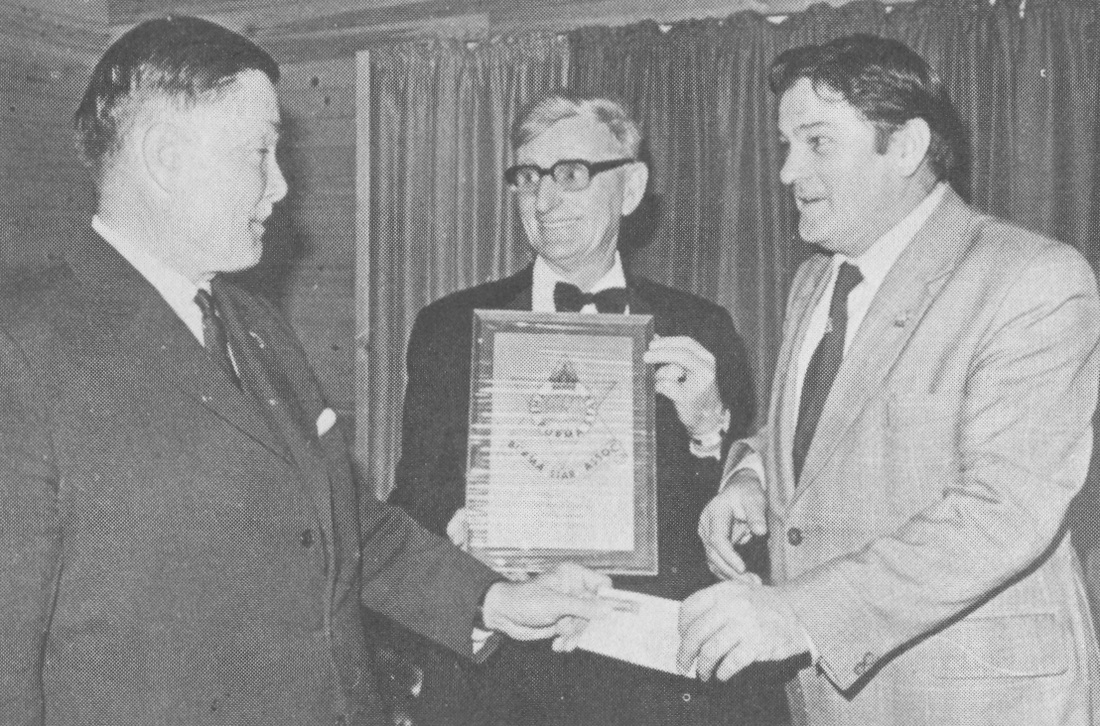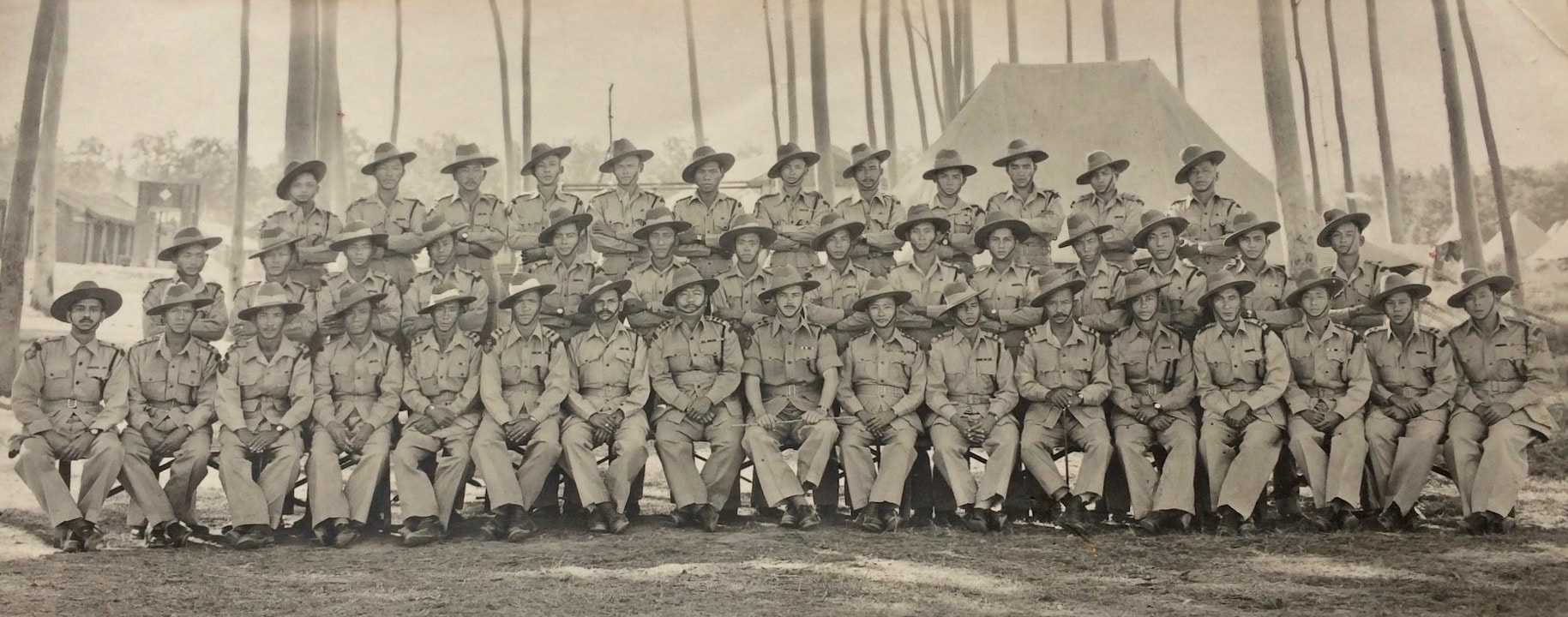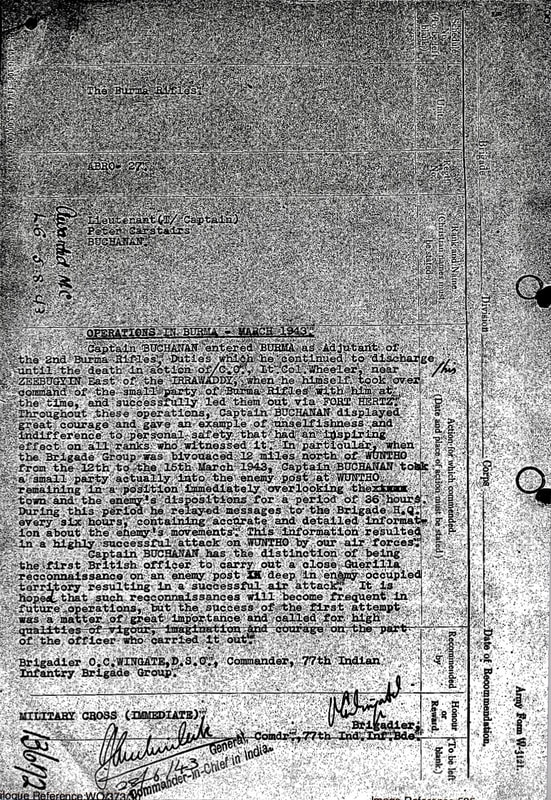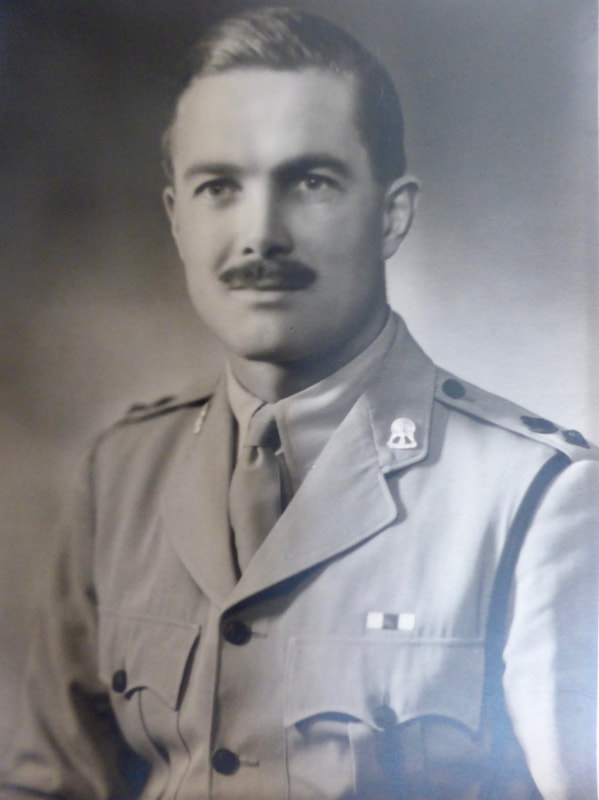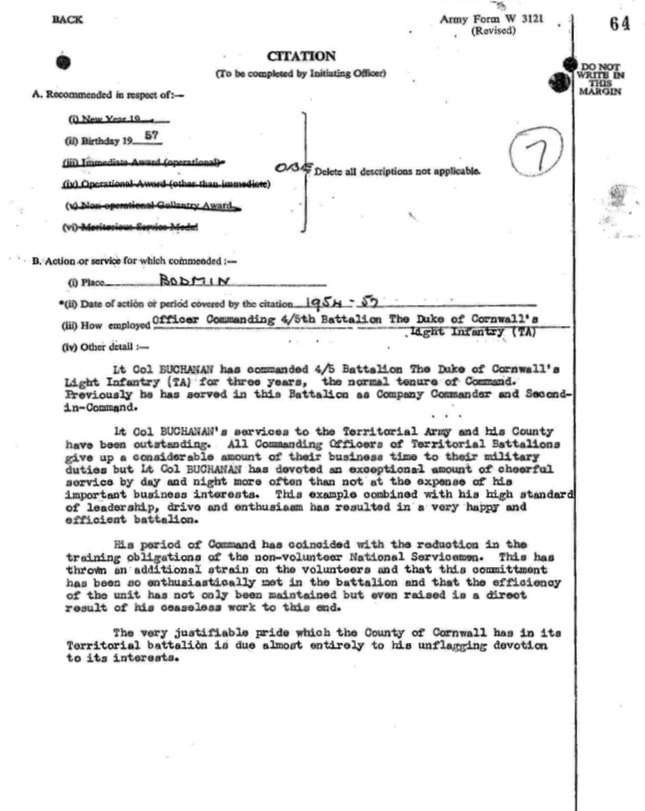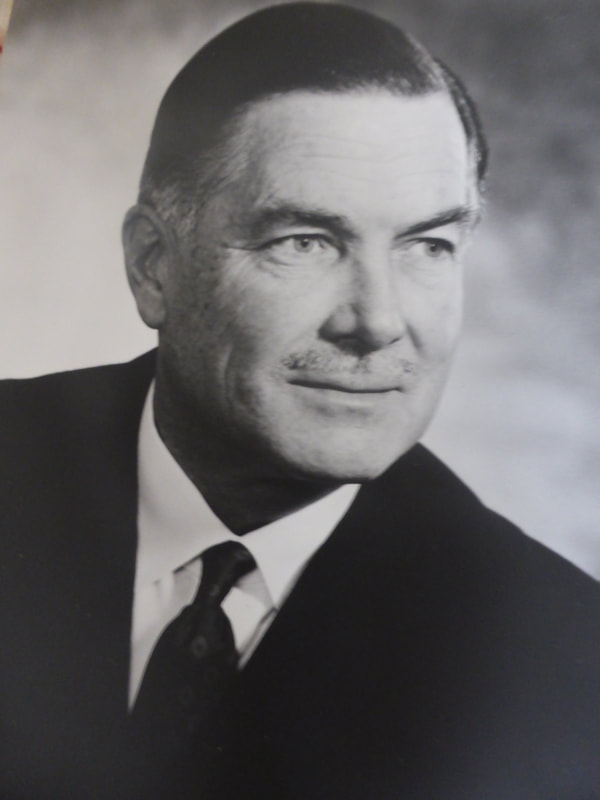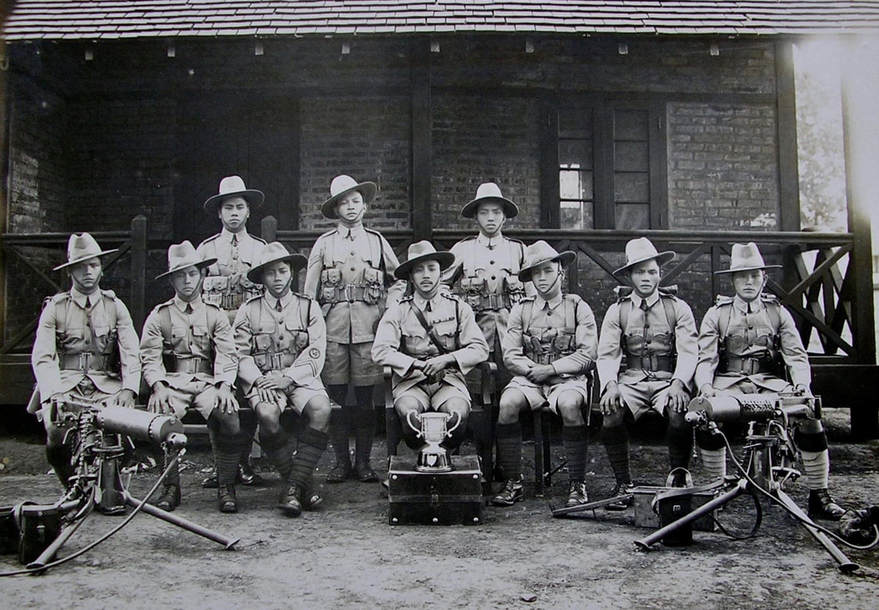2nd Battalion, The Burma Rifles
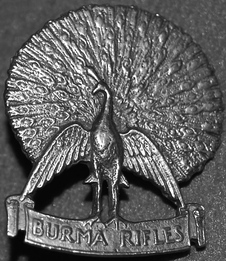 Cap badge of the Burma Rifles.
Cap badge of the Burma Rifles.
"I would like to record here that I have never had under my command in the field as good a body of men as the 2nd Burma Rifles. Their Commander, Lieutenant-Colonel Wheeler and myself were hopeful that the work of a reconnaissance unit for a Long Range Group would make full use of their good qualities, but we were surprised by their excellence in the face of the enemy.
As a result of the experience we gained, the following conclusions may be drawn. The Burman hillman is an ideal soldier for aggressive reconnaissance. He is not at all ideal in defence. He is not ideal if ordered to attack a strongly held position. But in carrying out rapid, bold and intelligent patrols in the face of the enemy, in obtaining local information, in making propaganda, in handling boats, in living off the country, and in loyal service to his officers he is without equal."
This is a quote from Brigadier Wingate's debrief report for Operation Longcloth, written after the Chindit leader had regained India in 1943 and had time to reflect on the performance of the men from the Karen, Kachin and Chin hill tribes of Burma.
Led by their officers; men taken from the varied industries across Burma such as timber, steel and petro-chemicals; these young and determined soldiers excelled in their role as guides, interpreters and finders of safe passage for the fledgling Chindit Brigade. Still pained by their experiences from the previous year, the Riflemen felt the need to recover their fighting spirit and rebuild their fortitude in order to expel the Japanese from their homeland.
Wingate also saw their worth as recruiters, organising a special mission in to the Kachin Hill tracts in 1943, led by Captain D. C. Herring. This unit moved quickly east ahead of the main Chindit body to spread positive propaganda amongst the pro-British tribes in the area and to recruit new levies for future operations against the Japanese. There was a codename for the propaganda and psychological warfare programme set up by the Chindits of 1943, the codename was 'elephantneverforgets'.
The battalion had originally been formed in January 1918 as the 2nd Battalion the 70th Burma Rifles. With battle honours which included Egypt in 1917 and Burma in 1930-32, the unit eventually obtained the name of 2nd Battalion, the Burma Rifles in 1937, after Burma had been officially separated from being a part of India. The battalion were first stationed at Mandalay, before moving across to Maymyo in 1939.
At the time of the Japanese invasion the 2nd Burma Rifles were part of the Tenasserim Infantry Brigade defending the southern sector of Burma, close to the border with Thailand. After failing to hold the Japanese in these early stages of the retreat in 1942, the battalion found itself based at Mingaladon on the outskirts of Rangoon on the 25th January. They then performed various rearguard manoeuvres until late May, when they finally passed over into India and came to rest at the town of Palel.
For a more detailed account of the battalion's history and activities during the infamous retreat from Burma in 1942, please click on the following link: http://www.rothwell.force9.co.uk/burmaweb/2ndburma.htm
More information about the 2nd Burma Rifles and other Burmese and Anglo-Burmese related military units in WW2 can be found on the following website: http://www.angloburmeselibrary.com/the-war-against-japan.html
Seen below is the War diary for the 2nd Burma Rifles Brigade Head Quarters during the months of Operation Longcloth. It was written and compiled by the then Captain, Peter Carstairs Buchanan who was promoted to Lieutenant-Colonel and commander of the battalion after the tragic death of Lieutenant-Colonel Lyndon Grier Wheeler in early April 1943. Please click on any image to bring it forward on the page. Please remember, this is only the diary for the battalion Head Quarters and does not recount the experiences of the Burma Rifle Platoons shared out between all the other Chindit Columns on Operation Longcloth.
As a result of the experience we gained, the following conclusions may be drawn. The Burman hillman is an ideal soldier for aggressive reconnaissance. He is not at all ideal in defence. He is not ideal if ordered to attack a strongly held position. But in carrying out rapid, bold and intelligent patrols in the face of the enemy, in obtaining local information, in making propaganda, in handling boats, in living off the country, and in loyal service to his officers he is without equal."
This is a quote from Brigadier Wingate's debrief report for Operation Longcloth, written after the Chindit leader had regained India in 1943 and had time to reflect on the performance of the men from the Karen, Kachin and Chin hill tribes of Burma.
Led by their officers; men taken from the varied industries across Burma such as timber, steel and petro-chemicals; these young and determined soldiers excelled in their role as guides, interpreters and finders of safe passage for the fledgling Chindit Brigade. Still pained by their experiences from the previous year, the Riflemen felt the need to recover their fighting spirit and rebuild their fortitude in order to expel the Japanese from their homeland.
Wingate also saw their worth as recruiters, organising a special mission in to the Kachin Hill tracts in 1943, led by Captain D. C. Herring. This unit moved quickly east ahead of the main Chindit body to spread positive propaganda amongst the pro-British tribes in the area and to recruit new levies for future operations against the Japanese. There was a codename for the propaganda and psychological warfare programme set up by the Chindits of 1943, the codename was 'elephantneverforgets'.
The battalion had originally been formed in January 1918 as the 2nd Battalion the 70th Burma Rifles. With battle honours which included Egypt in 1917 and Burma in 1930-32, the unit eventually obtained the name of 2nd Battalion, the Burma Rifles in 1937, after Burma had been officially separated from being a part of India. The battalion were first stationed at Mandalay, before moving across to Maymyo in 1939.
At the time of the Japanese invasion the 2nd Burma Rifles were part of the Tenasserim Infantry Brigade defending the southern sector of Burma, close to the border with Thailand. After failing to hold the Japanese in these early stages of the retreat in 1942, the battalion found itself based at Mingaladon on the outskirts of Rangoon on the 25th January. They then performed various rearguard manoeuvres until late May, when they finally passed over into India and came to rest at the town of Palel.
For a more detailed account of the battalion's history and activities during the infamous retreat from Burma in 1942, please click on the following link: http://www.rothwell.force9.co.uk/burmaweb/2ndburma.htm
More information about the 2nd Burma Rifles and other Burmese and Anglo-Burmese related military units in WW2 can be found on the following website: http://www.angloburmeselibrary.com/the-war-against-japan.html
Seen below is the War diary for the 2nd Burma Rifles Brigade Head Quarters during the months of Operation Longcloth. It was written and compiled by the then Captain, Peter Carstairs Buchanan who was promoted to Lieutenant-Colonel and commander of the battalion after the tragic death of Lieutenant-Colonel Lyndon Grier Wheeler in early April 1943. Please click on any image to bring it forward on the page. Please remember, this is only the diary for the battalion Head Quarters and does not recount the experiences of the Burma Rifle Platoons shared out between all the other Chindit Columns on Operation Longcloth.
The War diaries for the 2nd Burma Rifles can be found and viewed in the National Archive reading rooms at Kew, London. The file references are:
WO172/975 for the 1942 Diary: http://discovery.nationalarchives.gov.uk/details/r/C945342
WO172/2658 for the 1943 Diary: http://discovery.nationalarchives.gov.uk/details/r/C947029
Apart from the Burma Rifles Brigade HQ which contained around 120 personnel, there was also a Burma Rifles platoon in each of the seven Chindit Columns on Operation Longcloth. This was usually made up of 30-40 personnel and led by two British officers, one holding the rank of Captain, the other a Lieutenant. After this, there were Burmese officers holding the ranks of Subedar (senior native officer) and Jemadar, which was the equivalent of a 2nd Lieutenant in the British Army. Not many men with the rank of Subedar took part in the first Chindit expedition, leaving in most cases, the young Jemadars to perform the role of section commander. The rest of the platoon was made up of two Havildars (Sergeants), four Naiks (Corporals), Lance-Naiks and Riflemen.
Here is the composition, as far as I have been able to collate from books, war diaries and nominal rolls, of the Burma Rifle platoon for Chindit Column 5. In his book, Beyond the Chindwin, Bernard Fergusson described his Burma Riflemen thus:
Nobody who has served with Karens could fail to like them. Thoroughly biddable and mostly Christians, they make admirable soldiers, intelligent, willing, energetic and brave.
WO172/975 for the 1942 Diary: http://discovery.nationalarchives.gov.uk/details/r/C945342
WO172/2658 for the 1943 Diary: http://discovery.nationalarchives.gov.uk/details/r/C947029
Apart from the Burma Rifles Brigade HQ which contained around 120 personnel, there was also a Burma Rifles platoon in each of the seven Chindit Columns on Operation Longcloth. This was usually made up of 30-40 personnel and led by two British officers, one holding the rank of Captain, the other a Lieutenant. After this, there were Burmese officers holding the ranks of Subedar (senior native officer) and Jemadar, which was the equivalent of a 2nd Lieutenant in the British Army. Not many men with the rank of Subedar took part in the first Chindit expedition, leaving in most cases, the young Jemadars to perform the role of section commander. The rest of the platoon was made up of two Havildars (Sergeants), four Naiks (Corporals), Lance-Naiks and Riflemen.
Here is the composition, as far as I have been able to collate from books, war diaries and nominal rolls, of the Burma Rifle platoon for Chindit Column 5. In his book, Beyond the Chindwin, Bernard Fergusson described his Burma Riflemen thus:
Nobody who has served with Karens could fail to like them. Thoroughly biddable and mostly Christians, they make admirable soldiers, intelligent, willing, energetic and brave.
|
Captain John Coleridge Fraser MC
Lieutenant Philip Anthony Mair Heald Subedar Ba Than Jemadar Sao Man Hpa Jemadar Aung Pe Havildar Billy Havildar Po Po Tu Havidar Saw Lader Naik Jameson Naik Nay Dun Naik Tun So Ne Lance/Naik Ba U Lance/Naik Kang Tawng |
Rifleman Kyaw Thein
Rifleman San Khai Rifleman Robert Rifleman Washington Rifleman Saw Sein U Rifleman Saw Ohm Maung Rifleman Anthony Rifleman Ba Tun Rifleman Maung Kyan Rifleman Maung Tun Rifleman Nelson Rifleman Pa Haw |
Just before the operation began in February 1943, the officer commanding the 2nd Burma Rifles, Lieutenant-Colonel L. G. Wheeler spoke to Wingate about his men and their reasons for joining the Chindits. He was concerned that many of the Riflemen in particular, would attempt to remain behind inside Burma even after the operation was over. They had been driven from their homeland by the Japanese invasion force in 1942 and would have had no news about their families or loved ones for over twelve months.
Wheeler felt that the temptation for remaining behind would be almost impossible for his men to resist, and so he and Wingate developed a plan to keep these men together and ensure they returned to India and were available again for the second Chindit operation in 1944. The plan was quite simple, on dispersal in April 1943 they attached the Burma Rifles personnel to many of the smaller dispersal parties to act as guides and to source food in local villages on the long journey back. This gave the Rifleman a greater sense of responsibility, knowing that he could not leave the group to fend for themselves in such hostile and dangerous territory.
In his memoirs, Captain Maung Aung Thin DSO, an officer from Wingate's Brigade Head Quarters on Operation Longcloth, told of his worries for the safety of his own wife, Hta Hta and his two young daughters. He had last seen them in early 1942 and his concern was based on the Japanese discovering his own involvement with the Chindits and arresting and torturing his family in an act of reprisal. I am not sure how much this understandable concern on behalf of the ranks of the 2nd Burma Rifles was taken into consideration by the hierarchy of the first Chindit Brigade in the planning stages of the operation in the late summer of 1942, but, by the time the Brigade was ensconced behind enemy lines it was certainly at the forefront of their thinking.
Seen below are two images of the 2nd Burma Rifles, taken after their return to India in April/May 1943. The first, shows the men from the battalion who were awarded various Gallantry medals for their efforts on Operation Longcloth and again in 1944 on Operation Thursday. The second is a similar photograph showing Lieutenant P.A.M. Heald of 5 Column and the men from his platoon that had received awards for their service with the Chindits.
Wheeler felt that the temptation for remaining behind would be almost impossible for his men to resist, and so he and Wingate developed a plan to keep these men together and ensure they returned to India and were available again for the second Chindit operation in 1944. The plan was quite simple, on dispersal in April 1943 they attached the Burma Rifles personnel to many of the smaller dispersal parties to act as guides and to source food in local villages on the long journey back. This gave the Rifleman a greater sense of responsibility, knowing that he could not leave the group to fend for themselves in such hostile and dangerous territory.
In his memoirs, Captain Maung Aung Thin DSO, an officer from Wingate's Brigade Head Quarters on Operation Longcloth, told of his worries for the safety of his own wife, Hta Hta and his two young daughters. He had last seen them in early 1942 and his concern was based on the Japanese discovering his own involvement with the Chindits and arresting and torturing his family in an act of reprisal. I am not sure how much this understandable concern on behalf of the ranks of the 2nd Burma Rifles was taken into consideration by the hierarchy of the first Chindit Brigade in the planning stages of the operation in the late summer of 1942, but, by the time the Brigade was ensconced behind enemy lines it was certainly at the forefront of their thinking.
Seen below are two images of the 2nd Burma Rifles, taken after their return to India in April/May 1943. The first, shows the men from the battalion who were awarded various Gallantry medals for their efforts on Operation Longcloth and again in 1944 on Operation Thursday. The second is a similar photograph showing Lieutenant P.A.M. Heald of 5 Column and the men from his platoon that had received awards for their service with the Chindits.
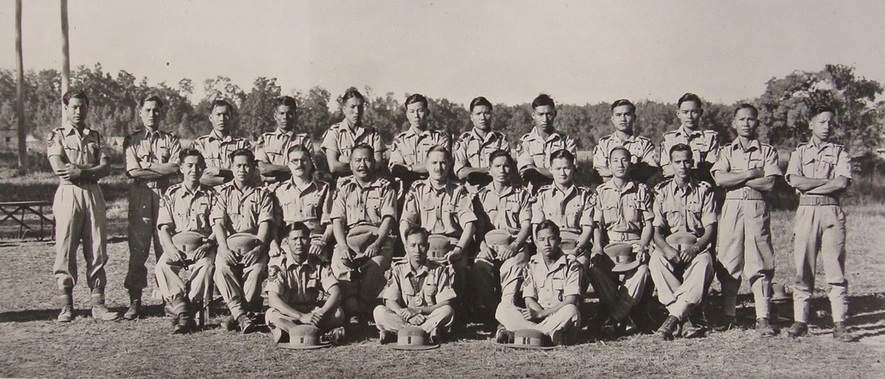
2nd Burma Rifles, Gallantry Award recipients including: middle row, third left: Captain W. D. Griffiths of 3 Column. Middle row, centre: Lieut-Col. P. C. Buchanan, Adjutant and middle row, third right: Captain Saw Chit Khin of 1 Column. All three men were awarded the Military Cross for their efforts in 1943.
After regaining the safety of India, the battalion spent a few weeks at Imphal, where during their period of hospitalisation they went through anti-malarial treatment as well as a programme to build up their physical strength. On June 4th they moved over to the Army Cantonment at Karachi, joining the 13th King's, who by this time were stationed at the Napier Barracks in the city. Officers and Other Ranks from the 2nd Burma Rifles came and went over the next few months, some taking well deserved leave in the hill station resorts of Assam. On the 9th August 1943 the battalion moved once again, this time to the Army Administration centre at Jhansi.
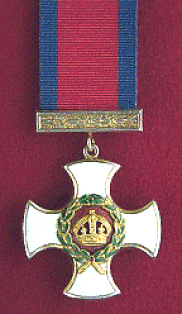 Distinguished Service Order.
Distinguished Service Order.
Lt-Colonel Lyndon Grier Wheeler
As mentioned earlier, the 2nd Battalion were originally led into Burma by Lieutenant-Colonel Lyndon Grier Wheeler. Wheeler, born on the 31st December 1900, was commissioned into the Indian Army on the 17th December 1919 and served with the Burma Rifles right through the following two decades up until his promotion to Major in 1937.
As Captain, he was Mentioned in Despatches for his distinguished service during the Saya San Rebellion in Burma from 1930-1932, this award was gazetted on the 20th December 1932. He was then placed on Special Employment as an Intelligence Officer in India from 1st April 1933 to 15th April 1935, after which time he served with the 16th Punjab Regiment.
In 1939 he became the Deputy Director of the Burmese Defence Bureau attached to the 1st Battalion, the Burma Rifles. In 1942 he was re-deployed to the Burma Army Command Head Quarters with the temporary rank of Lieutenant-Colonel. One of his tasks during this period was re-organising and re-fitting the men returning from the Sittang Bridge disaster. After this Wheeler took up command of the 2nd Burma Rifles as they began their preparations for the forthcoming Chindit operation planned for early 1943.
Lyndon Grier Wheeler was a very popular leader in 1943, not only did he have the full respect of his Burmese troops, but he had also made a good impression on Wingate and the other British Army officers commanding the Chindit columns. Sadly, he was not destined to return from Burma that year and was killed on the 4th April at a village called Zibyugin. For his efforts on Operation Longcloth he was awarded a posthumous Distinguished Service Order (seen left). The recommendation for this award reads:
Operations in Burma, February - May 1943
Major (T/Lt.Col.) WHEELER, Commander, 2 Burma Rifles was entrusted with preparing the way in advance of the main body of the Force. For this hazardous and vital task he was eminently suited since his knowledge of Burma and its people was unrivalled. He was thus well aware of the dangers and difficulties which columns would encounter in traversing enemy occupied territory - better indeed, than anyone in the Brigade - but he exerted himself throughout to encourage and sustain not only officers in his own unit but also those outside it.
To him was due the high standard of training achieved by his men, and throughout the operations he displayed infinite courage and daring. On several occasions leading the advance of the Brigade as he did, Wheeler with his party of 120 Riflemen, encountered and dealt with enemy patrols and during these clashes he exhibited perfect courage and coolness. The prominence of the Burma Rifles and the unqualified reliance placed on them by all the commanders throughout the campaign, is the best tribute to the personality of Lt-Colonel Wheeler and to the devotion which he inspired in all officers and men, whether British Burman or Gurkha.
(Since killed in action 04/04/1943).
Recommended By
Brigadier O.C. Wingate, DSO
Commander
77th Indian Infantry Brigade.
To view Lieutenant-Colonel Wheeler's CWGC details, please click on the following link:
http://www.cwgc.org/find-war-dead/casualty/2528414/WHEELER,%20LYNDON%20GRIER
Lieutenant-Colonel Wheeler and his Head Quarters had reached the village of Zibyugin a few days after Wingate had called for the full Chindit Brigade to disperse, this was after the hastily abandoned crossing at the Irrawaddy River on the 29th March. Earlier on the 4th April, a small recce party from 5 Column, led by Lieutenant Duncan Campbell Menzies had entered the village of Zibyugin in search of fresh rations. A description of the events of the 4th April at Zibyugin can be found in the book, 'Wingate's Adventure', by W. G. Burchett:
Next day Colonel Wheeler with Burma Rifles Headquarters Group came along the track leading towards this village. About midday he ordered a halt for tea, setting an ambush of ten men on the road half a mile each side of the main group. The men were told if Japs came along not to waste time sending back messages, but to wade straight into them. The noise of their rifle fire would be sufficient message.
Ten minutes after the rear block got into position a patrol of 35 Japs came leisurely along the road, rifles slung across their shoulders. The Burma Riflemen waited according to instruction until they could "count their eyelashes," and then opened up. Several Japs fell instantly, some rushed for the jungle and started firing, others tried to drag away the prostrate bodies. In the end they broke and ran, leaving 18 dead and dying Japs on the road. The Burma Riflemen had not lost a man, and swaggered back to their Colonel feeling very proud of themselves.
Meanwhile the other road block party had halted a villager who told them there were Japs in a village a couple of miles away. Wheeler decided to attack and try to get some food. They spread round three-quarters of a circle and advanced towards the first houses. The Japs showed little inclination to fight and rushed back into the jungle. Leaving a couple of platoons to prod them from tree to tree, Colonel Wheeler and Captain Buchanan took a handful of men into the village to try and find some food and Jap documents. While they were searching the houses, a Karen called out to Buchanan:
"There's a badly wounded Jap here. What shall I do with him?" Buchanan went to investigate and saw a shaven-headed soldier with a Jap uniform and helmet, blood trickling from a wound in his stomach and staggering to his feet to be sick. Then he noticed his arms were tied. Buchanan looked closer.
"That's not a Japanese," he called.
"No. It's Duncan Menzies," said the wounded man, and slumped to the ground again. Buchanan knelt down, cut the rope that bound him and put his arms round his shoulders. Although he was suffering greatly, Menzies insisted on talking.
"They grabbed me when I came back. Just had time fire the couple of warning shots I promised Bernard Fergusson. Shaved my face and head. Dunno why, and put on Jap uniform and helmet. Two hundred Japs here last night. All went away except about fifty that you chased out."
"Don't tell me we hit you when we attacked."
"No. Japs shot us both. Killed other poor bloke. Too great hurry and messed me up. You better shoot me now, Peter. Can't last long. Carry on along track to east and you'll catch up Bernard." He fumbled in his shirt pocket and pulled out a watch.
"Peter, if you get out this lot safely, I'd like you to send this back my family. Ask Bernard. He'll tell you where. Good luck old boy."
While Buchanan was still holding him, he died. Alongside him, also with shaven head and face, bound arms, and dressed in Jap clothes was the private (Charles Gilmartin) who had accompanied Menzies into the village. He had been killed instantly with a bullet through the brain.
Meanwhile the others were searching the village. They found 40 Jap packs, which they set alight, two bags of rice and plenty of mess-tins which they carried with them. Colonel Wheeler had been through most of the houses and was just entering a big bungalow that looked as if it might be Jap Headquarters, when there was a volley of automatic fire. He stepped back to get under cover, when there was a single rifle shot. He fell to the ground. A Kachin rushed to pick him up, but the bullet had entered his head just above his ear and he was dead.
So in this tiny village of Zibyugon, not even marked on a map, died two of the finest men in the Wingate Force. Wheeler was 43 years of age, the oldest man in the expedition, but with tons of energy and a great sense of humour. He had spent over twenty years in Burma and was well fitted to lead the Burma Rifles. Before the Pacific War started he had been in charge of the Defence Bureau in Rangoon, but he fought right through the Burma campaign. He spoke Burmese, Karen and Kachin fluently, and had great prestige throughout the Kachin Hills. Buchanan, who travelled through these hills afterwards, found the news of Wheeler's death had preceded him. He was mourned by the Kachins as a friend and great leader.
To read more about Duncan Campbell Menzies and Pte. Gilmartin, please click on the following link: Duncan Campbell Menzies
As mentioned earlier, the 2nd Battalion were originally led into Burma by Lieutenant-Colonel Lyndon Grier Wheeler. Wheeler, born on the 31st December 1900, was commissioned into the Indian Army on the 17th December 1919 and served with the Burma Rifles right through the following two decades up until his promotion to Major in 1937.
As Captain, he was Mentioned in Despatches for his distinguished service during the Saya San Rebellion in Burma from 1930-1932, this award was gazetted on the 20th December 1932. He was then placed on Special Employment as an Intelligence Officer in India from 1st April 1933 to 15th April 1935, after which time he served with the 16th Punjab Regiment.
In 1939 he became the Deputy Director of the Burmese Defence Bureau attached to the 1st Battalion, the Burma Rifles. In 1942 he was re-deployed to the Burma Army Command Head Quarters with the temporary rank of Lieutenant-Colonel. One of his tasks during this period was re-organising and re-fitting the men returning from the Sittang Bridge disaster. After this Wheeler took up command of the 2nd Burma Rifles as they began their preparations for the forthcoming Chindit operation planned for early 1943.
Lyndon Grier Wheeler was a very popular leader in 1943, not only did he have the full respect of his Burmese troops, but he had also made a good impression on Wingate and the other British Army officers commanding the Chindit columns. Sadly, he was not destined to return from Burma that year and was killed on the 4th April at a village called Zibyugin. For his efforts on Operation Longcloth he was awarded a posthumous Distinguished Service Order (seen left). The recommendation for this award reads:
Operations in Burma, February - May 1943
Major (T/Lt.Col.) WHEELER, Commander, 2 Burma Rifles was entrusted with preparing the way in advance of the main body of the Force. For this hazardous and vital task he was eminently suited since his knowledge of Burma and its people was unrivalled. He was thus well aware of the dangers and difficulties which columns would encounter in traversing enemy occupied territory - better indeed, than anyone in the Brigade - but he exerted himself throughout to encourage and sustain not only officers in his own unit but also those outside it.
To him was due the high standard of training achieved by his men, and throughout the operations he displayed infinite courage and daring. On several occasions leading the advance of the Brigade as he did, Wheeler with his party of 120 Riflemen, encountered and dealt with enemy patrols and during these clashes he exhibited perfect courage and coolness. The prominence of the Burma Rifles and the unqualified reliance placed on them by all the commanders throughout the campaign, is the best tribute to the personality of Lt-Colonel Wheeler and to the devotion which he inspired in all officers and men, whether British Burman or Gurkha.
(Since killed in action 04/04/1943).
Recommended By
Brigadier O.C. Wingate, DSO
Commander
77th Indian Infantry Brigade.
To view Lieutenant-Colonel Wheeler's CWGC details, please click on the following link:
http://www.cwgc.org/find-war-dead/casualty/2528414/WHEELER,%20LYNDON%20GRIER
Lieutenant-Colonel Wheeler and his Head Quarters had reached the village of Zibyugin a few days after Wingate had called for the full Chindit Brigade to disperse, this was after the hastily abandoned crossing at the Irrawaddy River on the 29th March. Earlier on the 4th April, a small recce party from 5 Column, led by Lieutenant Duncan Campbell Menzies had entered the village of Zibyugin in search of fresh rations. A description of the events of the 4th April at Zibyugin can be found in the book, 'Wingate's Adventure', by W. G. Burchett:
Next day Colonel Wheeler with Burma Rifles Headquarters Group came along the track leading towards this village. About midday he ordered a halt for tea, setting an ambush of ten men on the road half a mile each side of the main group. The men were told if Japs came along not to waste time sending back messages, but to wade straight into them. The noise of their rifle fire would be sufficient message.
Ten minutes after the rear block got into position a patrol of 35 Japs came leisurely along the road, rifles slung across their shoulders. The Burma Riflemen waited according to instruction until they could "count their eyelashes," and then opened up. Several Japs fell instantly, some rushed for the jungle and started firing, others tried to drag away the prostrate bodies. In the end they broke and ran, leaving 18 dead and dying Japs on the road. The Burma Riflemen had not lost a man, and swaggered back to their Colonel feeling very proud of themselves.
Meanwhile the other road block party had halted a villager who told them there were Japs in a village a couple of miles away. Wheeler decided to attack and try to get some food. They spread round three-quarters of a circle and advanced towards the first houses. The Japs showed little inclination to fight and rushed back into the jungle. Leaving a couple of platoons to prod them from tree to tree, Colonel Wheeler and Captain Buchanan took a handful of men into the village to try and find some food and Jap documents. While they were searching the houses, a Karen called out to Buchanan:
"There's a badly wounded Jap here. What shall I do with him?" Buchanan went to investigate and saw a shaven-headed soldier with a Jap uniform and helmet, blood trickling from a wound in his stomach and staggering to his feet to be sick. Then he noticed his arms were tied. Buchanan looked closer.
"That's not a Japanese," he called.
"No. It's Duncan Menzies," said the wounded man, and slumped to the ground again. Buchanan knelt down, cut the rope that bound him and put his arms round his shoulders. Although he was suffering greatly, Menzies insisted on talking.
"They grabbed me when I came back. Just had time fire the couple of warning shots I promised Bernard Fergusson. Shaved my face and head. Dunno why, and put on Jap uniform and helmet. Two hundred Japs here last night. All went away except about fifty that you chased out."
"Don't tell me we hit you when we attacked."
"No. Japs shot us both. Killed other poor bloke. Too great hurry and messed me up. You better shoot me now, Peter. Can't last long. Carry on along track to east and you'll catch up Bernard." He fumbled in his shirt pocket and pulled out a watch.
"Peter, if you get out this lot safely, I'd like you to send this back my family. Ask Bernard. He'll tell you where. Good luck old boy."
While Buchanan was still holding him, he died. Alongside him, also with shaven head and face, bound arms, and dressed in Jap clothes was the private (Charles Gilmartin) who had accompanied Menzies into the village. He had been killed instantly with a bullet through the brain.
Meanwhile the others were searching the village. They found 40 Jap packs, which they set alight, two bags of rice and plenty of mess-tins which they carried with them. Colonel Wheeler had been through most of the houses and was just entering a big bungalow that looked as if it might be Jap Headquarters, when there was a volley of automatic fire. He stepped back to get under cover, when there was a single rifle shot. He fell to the ground. A Kachin rushed to pick him up, but the bullet had entered his head just above his ear and he was dead.
So in this tiny village of Zibyugon, not even marked on a map, died two of the finest men in the Wingate Force. Wheeler was 43 years of age, the oldest man in the expedition, but with tons of energy and a great sense of humour. He had spent over twenty years in Burma and was well fitted to lead the Burma Rifles. Before the Pacific War started he had been in charge of the Defence Bureau in Rangoon, but he fought right through the Burma campaign. He spoke Burmese, Karen and Kachin fluently, and had great prestige throughout the Kachin Hills. Buchanan, who travelled through these hills afterwards, found the news of Wheeler's death had preceded him. He was mourned by the Kachins as a friend and great leader.
To read more about Duncan Campbell Menzies and Pte. Gilmartin, please click on the following link: Duncan Campbell Menzies
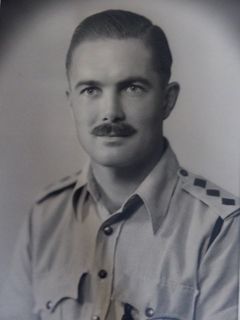 Captain Peter Carstairs Buchanan MC.
Captain Peter Carstairs Buchanan MC.
Captain Peter Carstairs Buchanan
"I was L.G. Wheeler's Adjutant and was only a few feet from him when he was hit and killed. His D.S.O. was awarded for the distinguished part he played in the first Wingate long range penetration operation."
This was how Captain Peter Carstairs Buchanan recalled the death of his commander in a reply to a letter he had received from a friend in 1967. Buchanan had been second in command of the Burma Rifles in 1943, but after Wheeler's death at Zibyugin, had assumed command of the unit, a position he would hold with the rank of Acting Lieutenant-Colonel for the rest of the year and into 1944.
Peter Buchanan was born on the 21st November 1912 in Esher, a town in the English county of Surrey. He was commissioned into the Indian Army with the service number ABRO 27 on the 10th November 1939. He became Adjutant to the 2nd Burma Rifles when the unit became part of the first Chindit operation in 1942-43. The 2nd Burma Rifles arrived at the Abchand Camp in the Central Provinces of India and entered into full Chindit training on the 17th September 1942. Here is how their arrival was recorded in the 13th Kings War diary for that period:
"The Burma Rifle detachment arrived today, they will be distributed to all Columns at the rate of 2 British Officers and 41 men to each."
Buchanan's performance in leading the battalion after Wheeler's death was exemplary and he was rewarded for his efforts on Operation Longcloth with a Military Cross. After the war he served with the Territorial Army as a Lieutenant-Colonel in the Duke of Cornwall's Light Infantry, for this service he was awarded the OBE in 1957.
Here is Captain Buchanan's Military Cross recommendation, which was Gazetted on the 5th August 1943:
OPERATIONS IN BURMA - MARCH 1943
Captain Buchanan entered Burma as Adjutant of the 2nd Burma Rifles. Duties which he continued to discharge until the death in action of his Commanding Officer, Lt.Col. Wheeler, near Zibyugin, east of the Irrawaddy, when he himself took over command of the small party of Burma Rifles with him at the time, and successfully led them out via Fort Hertz.
Throughout these operations, Captain Buchanan displayed great courage and gave an example of unselfishness and indifference to personal safety that had an inspiring effect on all ranks who witnessed it. In particular, when the Brigade Group was bivouaced 12 miles north of Wuntho from the 12th to the 15th March 1943, Captain Buchanan took a small party into the enemy post at Wuntho remaining in a position immediately overlooking the town and the enemy's dispositions for a period of 36 hours. During this period he relayed messages to the Brigade H.Q. every six hours, containing accurate and detailed information about the enemy's movements. This information resulted in a highly successful attack on Wuntho by our air forces.
Captain Buchanan has the distinction of being the first British Officer to carry out a close Guerilla reconnaissance on an enemy post deep in enemy occupied territory resulting in a successful air attack. It is hoped that such reconnaissances will become frequent in future operations, but the success of the first attempt was a matter of great importance and called for high qualities of vigour, imagination and courage on the part of the officer who carried it out.
Award Recommended By:
Brigadier O.C. Wingate, DSO
Commander 77th Indian Infantry Brigade Group
After the war Peter Buchanan left Burma for British shores, setting up home in the county of Cornwall. Sadly, he passed away on the 7th October 1990 at St. Ives. The Burma Star Association magazine (Dekho!) recorded his passing in their edition for the Summer of 1991:
"I was L.G. Wheeler's Adjutant and was only a few feet from him when he was hit and killed. His D.S.O. was awarded for the distinguished part he played in the first Wingate long range penetration operation."
This was how Captain Peter Carstairs Buchanan recalled the death of his commander in a reply to a letter he had received from a friend in 1967. Buchanan had been second in command of the Burma Rifles in 1943, but after Wheeler's death at Zibyugin, had assumed command of the unit, a position he would hold with the rank of Acting Lieutenant-Colonel for the rest of the year and into 1944.
Peter Buchanan was born on the 21st November 1912 in Esher, a town in the English county of Surrey. He was commissioned into the Indian Army with the service number ABRO 27 on the 10th November 1939. He became Adjutant to the 2nd Burma Rifles when the unit became part of the first Chindit operation in 1942-43. The 2nd Burma Rifles arrived at the Abchand Camp in the Central Provinces of India and entered into full Chindit training on the 17th September 1942. Here is how their arrival was recorded in the 13th Kings War diary for that period:
"The Burma Rifle detachment arrived today, they will be distributed to all Columns at the rate of 2 British Officers and 41 men to each."
Buchanan's performance in leading the battalion after Wheeler's death was exemplary and he was rewarded for his efforts on Operation Longcloth with a Military Cross. After the war he served with the Territorial Army as a Lieutenant-Colonel in the Duke of Cornwall's Light Infantry, for this service he was awarded the OBE in 1957.
Here is Captain Buchanan's Military Cross recommendation, which was Gazetted on the 5th August 1943:
OPERATIONS IN BURMA - MARCH 1943
Captain Buchanan entered Burma as Adjutant of the 2nd Burma Rifles. Duties which he continued to discharge until the death in action of his Commanding Officer, Lt.Col. Wheeler, near Zibyugin, east of the Irrawaddy, when he himself took over command of the small party of Burma Rifles with him at the time, and successfully led them out via Fort Hertz.
Throughout these operations, Captain Buchanan displayed great courage and gave an example of unselfishness and indifference to personal safety that had an inspiring effect on all ranks who witnessed it. In particular, when the Brigade Group was bivouaced 12 miles north of Wuntho from the 12th to the 15th March 1943, Captain Buchanan took a small party into the enemy post at Wuntho remaining in a position immediately overlooking the town and the enemy's dispositions for a period of 36 hours. During this period he relayed messages to the Brigade H.Q. every six hours, containing accurate and detailed information about the enemy's movements. This information resulted in a highly successful attack on Wuntho by our air forces.
Captain Buchanan has the distinction of being the first British Officer to carry out a close Guerilla reconnaissance on an enemy post deep in enemy occupied territory resulting in a successful air attack. It is hoped that such reconnaissances will become frequent in future operations, but the success of the first attempt was a matter of great importance and called for high qualities of vigour, imagination and courage on the part of the officer who carried it out.
Award Recommended By:
Brigadier O.C. Wingate, DSO
Commander 77th Indian Infantry Brigade Group
After the war Peter Buchanan left Burma for British shores, setting up home in the county of Cornwall. Sadly, he passed away on the 7th October 1990 at St. Ives. The Burma Star Association magazine (Dekho!) recorded his passing in their edition for the Summer of 1991:
Lieutenant-Colonel P.C. Buchanan, OBE, MC, TD of the 2nd Burma Rifles.
Burma Star Association Branch, West Cornwall.
Burma Star Association Branch, West Cornwall.
Peter did great work for the Burma Star Association in the decades after the war, including fund raising for those Burma veterans who had fallen upon hard times since returning home to the United Kingdom. Seen below is a photograph from 1974, which shows Peter (left as we look) accepting a welfare fund raising cheque from a local business representative.
Update 05/01/2019.
In December last year (2018), I was delighted to receive the following email from Peter Buchanan’s eldest daughter, Airlie:
My father, Peter Buchanan, was Lt. Colonel Wheeler's Adjutant on Operation Longcloth and when he was killed in April 1943 my father took over command of the 2nd Battalion, the Burma Rifles as Lt. Colonel. He had formerly been in the 10th (recruiting) Battalion in 1942 and had been in Burma since 1937 working with the Bombay-Burmah Trading Company.
This email is just to say how much my family and I have enjoyed reading the articles on your website, and I am really fascinated reading my father's war diary from March 1st 1943 to June 30th 1943. He never talked much about the war and I wish he was still alive as I have so many questions. He was a very special man.
He knew Jimmy Williams (Elephant Bill), who had been in Burma since the early 1920's and was also from Cornwall. I believe it was Jimmy who suggested that my father should go out to Burma, which he did in 1937. From my father’s letters I have deduced he was in the CAS(B), the Civil Administrative Service as an officer on special duty in the Agriculture and Rural Economy Department, dealing with local Burmese disputes at least from February to May 1945. Being wartime the letters are censored, but I get the feeling he was based in Katha on the Irrawaddy.
From Dad’s copy of Wingate’s Raiders by Charles J. Rolo, I read that three days before the main body of 77 Brigade left Imphal, Wingate had dispatched an advance party under Lt. Colonel Wheeler, which included Dad and Flight-Lieutenant Robert Thompson, to reconnoitre the crossing of the Chindwin, and on February 11th, Wheeler sent my father with a section of Burma Rifles and two elephants to blaze a trail over the mountain range which would carry them down to the river at an out-of-the-way spot. The book goes on to say how difficult this was and the next day, the 12th, they went into a friendly village who organised boats for the crossing, on the 13th a full report was wirelessed back to Brigade Headquarters and the crossing started at dusk under a full moon. A few pages later in the book it says the following, and I quote:
Two days before the main body of the Northern Force had started the river crossing Wingate had ordered Flight Lieutenant Thompson and Captain Peter Buchanan to push ahead and select a point eight to ten miles east of the Chindwin for a supply-dropping. Here all the northern columns were to meet, collect their supplies, and then fan out over a wide front. At dawn on February 14th, Thompson sent out a preliminary wireless message to the air base in Assam, all communication with base was in an unbreakable code listing the supplies needed: six days paratroop rations for each man and grain for the mules. Then he and Buchanan set off into the jungle on horseback.
At every village they stopped to collect information about the Japanese. Buchanan, a former employee of a Burma Trading Company, spoke the language fluently. Japanese patrols, they were told, had not been in the area for a week or two. The jungle track led into a grassy valley, and they had a very pleasant gallop. It reminded them of Sunday morning rides in the hills of Kashmir, where they had convalesced together the year before, Thompson after his escape from Hong Kong, and Buchanan from wounds received in the Burma Campaign. Eventually they found a suitable place for the supply dropping - a strip of marshy elephant grass with a clearing in the middle. They made for the nearest village (Tonmakeng) to water their horses, and were invited by the Burmese to share a meal of rice wrapped in palm-leaves, eggs and green tea which the Thugyi, or Headman ceremoniously prepared for them himself.
I found this quote of great interest, as I did not know my father had been wounded in 1942, or what he was doing after leaving Maymyo. In his letters he mentions losing some of his belongings when the boat he was travelling on sunk in the Irrawaddy during the retreat. He had buried other possessions up at Maymyo which were also never recovered, so I guess he must have left Burma in 1942 with more or less nothing.
All the best and many thanks, Airlie.
Seen below is a photograph sent to me by Airlie, showing her father with a large group of officers from the 2nd Battalion of the Burma Rifles at Dehra Dun. I believe this to be the battalion's gallantry award recipients from the two Chindit operations in 1943 and 1944. Please click on the image to bring it forward on the page.
In December last year (2018), I was delighted to receive the following email from Peter Buchanan’s eldest daughter, Airlie:
My father, Peter Buchanan, was Lt. Colonel Wheeler's Adjutant on Operation Longcloth and when he was killed in April 1943 my father took over command of the 2nd Battalion, the Burma Rifles as Lt. Colonel. He had formerly been in the 10th (recruiting) Battalion in 1942 and had been in Burma since 1937 working with the Bombay-Burmah Trading Company.
This email is just to say how much my family and I have enjoyed reading the articles on your website, and I am really fascinated reading my father's war diary from March 1st 1943 to June 30th 1943. He never talked much about the war and I wish he was still alive as I have so many questions. He was a very special man.
He knew Jimmy Williams (Elephant Bill), who had been in Burma since the early 1920's and was also from Cornwall. I believe it was Jimmy who suggested that my father should go out to Burma, which he did in 1937. From my father’s letters I have deduced he was in the CAS(B), the Civil Administrative Service as an officer on special duty in the Agriculture and Rural Economy Department, dealing with local Burmese disputes at least from February to May 1945. Being wartime the letters are censored, but I get the feeling he was based in Katha on the Irrawaddy.
From Dad’s copy of Wingate’s Raiders by Charles J. Rolo, I read that three days before the main body of 77 Brigade left Imphal, Wingate had dispatched an advance party under Lt. Colonel Wheeler, which included Dad and Flight-Lieutenant Robert Thompson, to reconnoitre the crossing of the Chindwin, and on February 11th, Wheeler sent my father with a section of Burma Rifles and two elephants to blaze a trail over the mountain range which would carry them down to the river at an out-of-the-way spot. The book goes on to say how difficult this was and the next day, the 12th, they went into a friendly village who organised boats for the crossing, on the 13th a full report was wirelessed back to Brigade Headquarters and the crossing started at dusk under a full moon. A few pages later in the book it says the following, and I quote:
Two days before the main body of the Northern Force had started the river crossing Wingate had ordered Flight Lieutenant Thompson and Captain Peter Buchanan to push ahead and select a point eight to ten miles east of the Chindwin for a supply-dropping. Here all the northern columns were to meet, collect their supplies, and then fan out over a wide front. At dawn on February 14th, Thompson sent out a preliminary wireless message to the air base in Assam, all communication with base was in an unbreakable code listing the supplies needed: six days paratroop rations for each man and grain for the mules. Then he and Buchanan set off into the jungle on horseback.
At every village they stopped to collect information about the Japanese. Buchanan, a former employee of a Burma Trading Company, spoke the language fluently. Japanese patrols, they were told, had not been in the area for a week or two. The jungle track led into a grassy valley, and they had a very pleasant gallop. It reminded them of Sunday morning rides in the hills of Kashmir, where they had convalesced together the year before, Thompson after his escape from Hong Kong, and Buchanan from wounds received in the Burma Campaign. Eventually they found a suitable place for the supply dropping - a strip of marshy elephant grass with a clearing in the middle. They made for the nearest village (Tonmakeng) to water their horses, and were invited by the Burmese to share a meal of rice wrapped in palm-leaves, eggs and green tea which the Thugyi, or Headman ceremoniously prepared for them himself.
I found this quote of great interest, as I did not know my father had been wounded in 1942, or what he was doing after leaving Maymyo. In his letters he mentions losing some of his belongings when the boat he was travelling on sunk in the Irrawaddy during the retreat. He had buried other possessions up at Maymyo which were also never recovered, so I guess he must have left Burma in 1942 with more or less nothing.
All the best and many thanks, Airlie.
Seen below is a photograph sent to me by Airlie, showing her father with a large group of officers from the 2nd Battalion of the Burma Rifles at Dehra Dun. I believe this to be the battalion's gallantry award recipients from the two Chindit operations in 1943 and 1944. Please click on the image to bring it forward on the page.
From the Cornishman newspaper, published October 25th 1990:
A Man Who Set Standards
Colonel Peter Buchanan, who died on the 7th October 1990, was born in Esher on the 21st November 1912. His family moved to Lelant, West Cornwall at the outbreak of first World War and Peter lived here for much of his life. He was educated at Probus School located near Truro and then Blundell’s School at Tiverton. He worked for Harvey & Co. Ltd. on leaving school, but soon got bored with sitting on an office stool, and so after winning the Cornwall Golf Championship in 1933 and a spell serving with the Duke of Cornwall’s Light Infantry as a Territorial, he joined the Bombay-Burmah Corporation and worked in the teak forests with elephants.
Having survived the retreat from Burma against the oncoming Japanese forces, he was to lead the 2nd Battalion, the Burma Rifles during the Wingate expedition of 1943. For his efforts in 1942 and 1943, Colonel Buchanan was awarded the Military Cross.
Peter returned to Cornwall and Harvey & Co. after the war and devoted his considerable energies in developing the building materials side of the business with great success, resulting in making the company the leading timber and builders merchants in the county. He was appointed to the board in 1948 and became Chairman in 1959. After several mergers, the business went on to become a national concern, with Peter remaining on the board until his retirement in 1973.
His interests were not confined to business. He re-joined the Territorial Army on its re-organisation after the war, commanding the 4/5th Duke of Cornwall’s Light Infantry between 1954 and 1957. His services with the TA were recognised in 1957 with the award of an O.B.E. He was Brigade Colonel of the 130th Infantry Brigade (TA) until 1960 and commanded the Cornwall Army Cadet Force for three more years, before his retirement from the Territorial Army in 1963.
Amongst other varied activities, he became a Deputy Lieutenant for the County of Cornwall in 1960, the Chairman of the National Federation of Builders and Plumbers Merchants during the early 1970’s and the Chairman of South Crofty Mine Ltd, master-minding its floatation as a public company. He was keen and successful golfer and a founder member and President of the Cornwall County Amateur Squash Association.
Peter was Churchwarden of the Lelant Parish Church and Chairman of the St. Ives branch of the Conservative Association and involved with the Overseas League and St. John’s Ambulance. He was an active member and President of the West Cornwall Branch of the Burma Star Association and an active member the DCLI Old Comrades Association. Peter never took a back seat in anything that he did. His strongest characteristic was his leadership, always demanding from others the same high standards he set himself. Above all he was a strong and loving family man.
A Man Who Set Standards
Colonel Peter Buchanan, who died on the 7th October 1990, was born in Esher on the 21st November 1912. His family moved to Lelant, West Cornwall at the outbreak of first World War and Peter lived here for much of his life. He was educated at Probus School located near Truro and then Blundell’s School at Tiverton. He worked for Harvey & Co. Ltd. on leaving school, but soon got bored with sitting on an office stool, and so after winning the Cornwall Golf Championship in 1933 and a spell serving with the Duke of Cornwall’s Light Infantry as a Territorial, he joined the Bombay-Burmah Corporation and worked in the teak forests with elephants.
Having survived the retreat from Burma against the oncoming Japanese forces, he was to lead the 2nd Battalion, the Burma Rifles during the Wingate expedition of 1943. For his efforts in 1942 and 1943, Colonel Buchanan was awarded the Military Cross.
Peter returned to Cornwall and Harvey & Co. after the war and devoted his considerable energies in developing the building materials side of the business with great success, resulting in making the company the leading timber and builders merchants in the county. He was appointed to the board in 1948 and became Chairman in 1959. After several mergers, the business went on to become a national concern, with Peter remaining on the board until his retirement in 1973.
His interests were not confined to business. He re-joined the Territorial Army on its re-organisation after the war, commanding the 4/5th Duke of Cornwall’s Light Infantry between 1954 and 1957. His services with the TA were recognised in 1957 with the award of an O.B.E. He was Brigade Colonel of the 130th Infantry Brigade (TA) until 1960 and commanded the Cornwall Army Cadet Force for three more years, before his retirement from the Territorial Army in 1963.
Amongst other varied activities, he became a Deputy Lieutenant for the County of Cornwall in 1960, the Chairman of the National Federation of Builders and Plumbers Merchants during the early 1970’s and the Chairman of South Crofty Mine Ltd, master-minding its floatation as a public company. He was keen and successful golfer and a founder member and President of the Cornwall County Amateur Squash Association.
Peter was Churchwarden of the Lelant Parish Church and Chairman of the St. Ives branch of the Conservative Association and involved with the Overseas League and St. John’s Ambulance. He was an active member and President of the West Cornwall Branch of the Burma Star Association and an active member the DCLI Old Comrades Association. Peter never took a back seat in anything that he did. His strongest characteristic was his leadership, always demanding from others the same high standards he set himself. Above all he was a strong and loving family man.
As mentioned in the above obituary, Peter Buchanan was awarded an O.B.E. in the Queen's birthday honour's list for 1957. The citation reads:
Lt-Colonel Buchanan has commanded 4/5th Battalion, The Duke of Cornwall's Light Infantry (TA) for three years, the normal tenure of command. Previously, he has served in this Battalion as Company Commander and Second-in-Command.
Lt-Colonel Buchanan's services to the Territorial Army and his County have been outstanding. All Commanding Officers of Territorial Battalions give up a considerable amount of their business time to their military duties, but Colonel Buchanan has devoted an exceptional amount of cheerful service by day and night, more often than not at the expense of his important business interests. This example combined with his high standard of leadership, drive and enthusiasm has resulted in a very happy and efficient battalion.
His period of command has coincided with the reduction in the training obligations of the non-volunteer National Servicemen. This has thrown an additional strain on the volunteers and that this commitment has been so enthusiastically met in the battalion and that the efficiency of the unit has not only been maintained but even raised, is a direct result of his ceaseless work to this end. The very justifiable pride which the County of Cornwall has in its Territorial Battalion is due almost entirely to his unflagging devotion to its interests.
I would like to thank Airlie Buchanan for the wonderful photographs she has added to her father's story on these website pages and for the other information given about his remarkably full and interesting life. In the case of his O.B.E. Airlie recalled:
I remember my sister and I went to Buckingham Palace with my father when he was awarded the O.B.E., I think by the Queen. This was very exciting for us as I guess we probably hadn't been to London much, or even at all, let alone the Palace.
Seen below is a gallery of images in relation to this story, including the official recommendations for both Lt-Colonel Buchanan's military awards. Please click on any image to bring it forward on the page.
Lt-Colonel Buchanan has commanded 4/5th Battalion, The Duke of Cornwall's Light Infantry (TA) for three years, the normal tenure of command. Previously, he has served in this Battalion as Company Commander and Second-in-Command.
Lt-Colonel Buchanan's services to the Territorial Army and his County have been outstanding. All Commanding Officers of Territorial Battalions give up a considerable amount of their business time to their military duties, but Colonel Buchanan has devoted an exceptional amount of cheerful service by day and night, more often than not at the expense of his important business interests. This example combined with his high standard of leadership, drive and enthusiasm has resulted in a very happy and efficient battalion.
His period of command has coincided with the reduction in the training obligations of the non-volunteer National Servicemen. This has thrown an additional strain on the volunteers and that this commitment has been so enthusiastically met in the battalion and that the efficiency of the unit has not only been maintained but even raised, is a direct result of his ceaseless work to this end. The very justifiable pride which the County of Cornwall has in its Territorial Battalion is due almost entirely to his unflagging devotion to its interests.
I would like to thank Airlie Buchanan for the wonderful photographs she has added to her father's story on these website pages and for the other information given about his remarkably full and interesting life. In the case of his O.B.E. Airlie recalled:
I remember my sister and I went to Buckingham Palace with my father when he was awarded the O.B.E., I think by the Queen. This was very exciting for us as I guess we probably hadn't been to London much, or even at all, let alone the Palace.
Seen below is a gallery of images in relation to this story, including the official recommendations for both Lt-Colonel Buchanan's military awards. Please click on any image to bring it forward on the page.
Seen below are links to more stories involving the exploits of the men from the 2nd Burma Rifles in 1943, including more photographs, memoirs, citations and a developing Roll Call of participants. Please click on any link to view these pages.
Copyright © Steve Fogden 2014.
